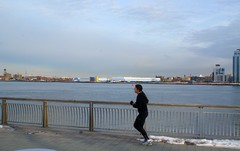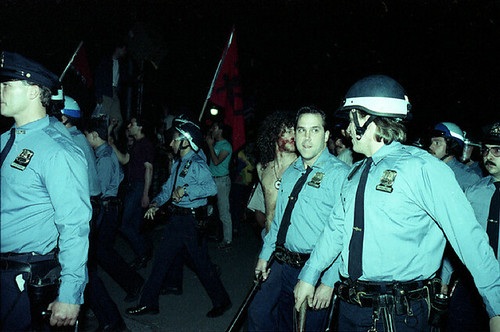 John Penley
John PenleyBefore today’s May Day festivities kick off, let’s turn the clock back 22 years, to May 1, 1990. That’s when an affordable-housing festival in Tompkins Square Park ended in a riot in which 28 police officers were injured and 29 people – some of them activists, anarchists, and squatters who had participated in the better known riots two years earlier – were arrested.
In this account reprinted from Clayton Patterson’s book, “Resistance: A Radical Social and Political History of the Lower East Side,” Ellen Moynihan, a writer and photographer who lately has been documenting Occupy Wall Street, describes how the melee began, and offers historical context going back to the 1800s, when May 1 was the time when many Lower East Side tenement dwellers’ leases would expire, causing mass migration. Read more…
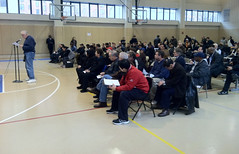 Stephen Rex Brown A member of the Just For Kicks adult softball league (left) testifies at today’s hearing.
Stephen Rex Brown A member of the Just For Kicks adult softball league (left) testifies at today’s hearing.The proposed changes to the system governing ball fields in city parks drew around 140 people today, many of whom expressed concern that a new priority for youth leagues would end up pushing adult games out.
If the reforms by the Parks Department are approved, youth leagues will be given priority when considering new ball-field permit applications.
“It’s silly to think this can’t lead to adult leagues being pushed out entirely,” said David Nierenberg, who plays in the Mundys Softball League in Brooklyn. “I don’t think that’s fair.” Read more…
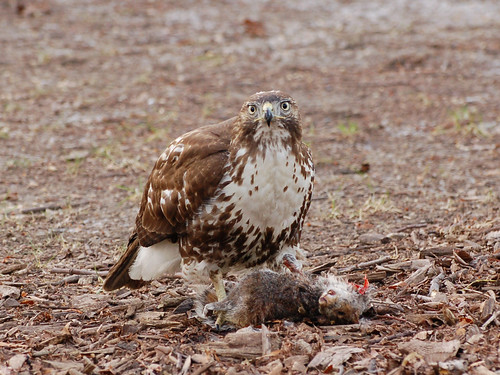 Robert Schmunk The Parks Department has begun placing rat poison in Tompkins Square Park, a measure it previously declined to use because of the presence of red- tailed hawks.
Robert Schmunk The Parks Department has begun placing rat poison in Tompkins Square Park, a measure it previously declined to use because of the presence of red- tailed hawks.The city has unleashed a new weapon in the fight against the rodent menace in Tompkins Square Park.
After destroying rodent hideouts and deploying mint-scented trash bags, new garbage cans, and “Feed a pigeon, breed a rat” signage, this week the Parks Department began baiting the park with poison.
Previously, the Parks Department had said it did not use rat poison due to the danger it posed to the red-tailed hawks that dine on the critters. But now, new Parks Department policy allows the agency to use poison when hawks are not in the fledgling season, which is roughly from February to August. Read more…
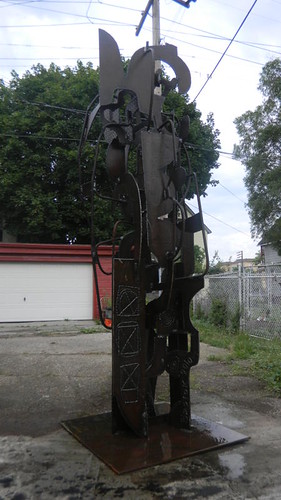 Courtesy of Robert Sestok. “First St. Iron.”
Courtesy of Robert Sestok. “First St. Iron.”What will happen to the BMW Guggenheim Lab once it packs up its video screens and moves on to Berlin? Members of First Street Green – the community group that for years lobbied the city to renovate the lot at Houston Street and Second Avenue – held a brainstorming event at the Lab on Saturday to answer just that. This much is certain: They’ve secured approval from the Parks Department, which owns the land, to install a new sculpture by Robert Sestok, a Detroit-based artist who has been visiting New York for three decades.
Mr. Sestok, who said he has been involved with Detroit’s influential Cass Corridor art movement since the 1970s, called “First St. Iron,” his welded steel sculpture, “a tribute to my past associations with the city of New York.” The piece was inspired by the wrought iron fences lining the streets near a friend’s house in the East Village. Read more…
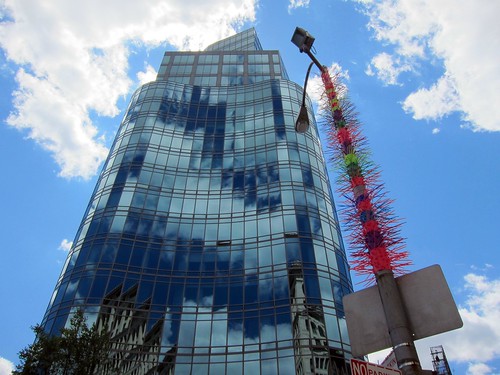 Scott Lynch
Scott LynchAccording to DNAinfo and other sites, including NYC.gov’s slow-moving Office of Emergency Management page, parts of the East Village are among the “Zone A” areas most at risk should Hurricane Irene strike Manhattan: “In the East Village, Zone A extends to Avenue D from East 4th Street to East 8th Street. From there, it extends to Avenue B up to 14th Street.” If evacuations are called for, shelters opening at 4 pm on Friday include Seward Park High School (350 Grand Street) and Baruch College (East 23rd Street and Lexington Avenue). Hurricane or no hurricane, the Tompkins Square Park leg of the Charlie Parker Jazz Festival, on Sunday, has been canceled, according to a press release picked up by Brooklyn Vegan.
Both the Villager and EV Grieve have the latest on what the Parks Department is doing to fight the Tompkins Square Park rats. NY1 also ran a story, and shortly before 11 p.m. last night, The Local spotted “Inside Edition” filming a segment that a crewperson said would air in about two or three weeks. Neither More Nor Less has photos.
Amidst worries that the Free Willie Nelson has been parking in Park Slope lately, The Daily News profiles the iconic RV and its owner Ron Britt, who says he wanted the vehicle’s interior to feel “a little like a Texas whorehouse.” Read more…
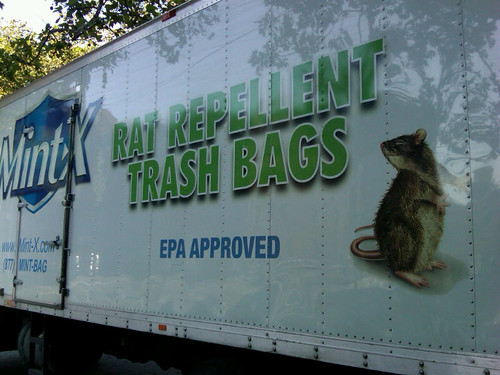 Tompkins Square Park Playground and Parents’ Association The truck carrying 5,000 mint-scented trash bags arrived at Parks Department offices in Lower Manhattan this morning.
Tompkins Square Park Playground and Parents’ Association The truck carrying 5,000 mint-scented trash bags arrived at Parks Department offices in Lower Manhattan this morning.A truckload of mint-scented trash bags have been donated to the Parks Department in the latest volley in the ongoing war against the rats of Tompkins Square Parks.
A spokesman for the Tompkins Square Park Playground and Parents’ Association, which secured the 5,000 minty bags, said that Mint-X recently made the offer to donate all the bags after seeing all the publicity the rats were attracting.
“If the rats don’t touch it, the Mint-X guy is looking at a big purchase from the city,” said the spokesman. “I’m hopeful that they’ll work.” He added that the bags should be in trash cans at Tompkins Square Park today. Read more…
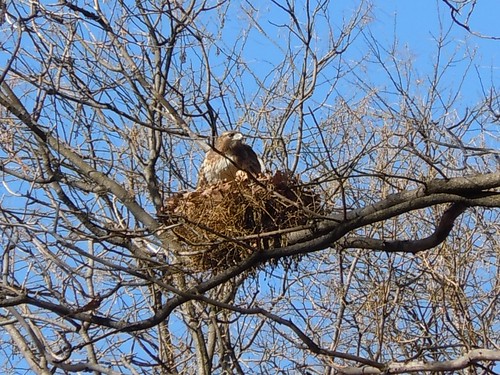 Carol Vinzant A red-tailed hawk in its nest in Tompkins Square Park earlier this year. Officials said that they stopped placing rat poison in the park to protect birds of prey, which feed on the rodents.
Carol Vinzant A red-tailed hawk in its nest in Tompkins Square Park earlier this year. Officials said that they stopped placing rat poison in the park to protect birds of prey, which feed on the rodents.Lately the hoards of rats scurrying all over Tompkins Square Park have disgusted local parents taking their children to the playground. Now, an ironic — and unwitting — culprit has emerged as the reason for the boom in rats: red-tailed hawks.
The Parks Department told The Local Monday that it stopped placing rat poison in the East Village’s green oasis in April because it could pose a danger to the feathered carnivores, which feed on the rodents.
“We are not placing rat poison in Tompkins Square because of the hawk,” said Philip Abramson, a spokesman for the Parks Department. “Instead we have replaced the garbage baskets with garbage drums, preventing rats from accessing its insides.”
The red-tailed hawk was first noticed this month on EV Grieve keeping vigil over the park, and occasionally feasting on a rat. Around the same time, a new parent group, Tompkins Square Park & Playgrounds Parents’ Association, sounded the alarm on the rats in The Villager, saying the critters were even burrowing in the sandbox.
As it turns out, the two occurrences are related. A poisoned rat can be a fatal feast for a hawk, especially a juvenile one.
Read more…
Locals will soon be able to surf the web while lounging in Tompkins Square Park, thanks to a new initiative that will install free Wi-Fi service at 20 city parks. Mayor Michael R. Bloomberg announced the measure at a news conference at Battery Park today alongside executives from AT&T, which will administer the service. The free wireless signal for smartphones, tablets and old-fashioned computers will be available in Tompkins Square Park by the end of the summer, according to Mr. Bloomberg.—Stephen Rex Brown
There are 39 community gardens in the East Village, with one located on nearly every street between East Houston and 14th Street. Ranging from tiny outdoor nooks overflowing with tulips to wide double lots large enough to hold amphitheaters, the gardens offer welcomed botanical getaways from the grit of the city.
But today, urban green spaces face a new threat as lawmakers in Washington D.C. continue to mull over budget cuts to federally funded community development programs including Green Thumb, which provides New York City community gardens with workshops, tools and other necessary supplies.
“Unfortunately, it’s a possibility in all aspects of the government,” said Larry Scott Blackmon, deputy commissioner of community outreach for the NYC Parks Department.
It is a crisis some gardens may be unprepared to face. Grace Tankersley, author of “Community Gardens of the East Village,” said Green Thumb has been a valuable resource for years.
“I don’t know what would happen to the gardens without Green Thumb if it was seriously cut back or destroyed,” Ms. Tankersley said. “At the moment it seems to be a little bit up in the air. Green Thumb is funded totally through the federal government so if they lose their funding the parks department may come through with funding, although they’ve had to cut back on their budget too.”
Read more…
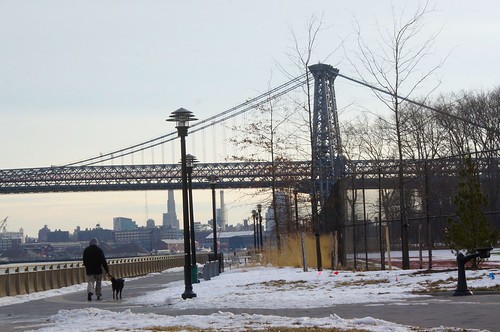 Suzanne Rozdeba The East River Park is the focal point of an unrealized plan for a unbroken protected greenway on Manhattan’s east side. Below: The park, renamed for former Mayor John V. Lindsay in 2001, is also a hub for runners and cyclists.
Suzanne Rozdeba The East River Park is the focal point of an unrealized plan for a unbroken protected greenway on Manhattan’s east side. Below: The park, renamed for former Mayor John V. Lindsay in 2001, is also a hub for runners and cyclists.Before the construction of the East River (later FDR) Drive and the public housing along the east side of the street, Avenue D’s relationship with the East River was much more direct than we see now. When the area was still dominated by an active industrial waterfront, almost every east-west street in the neighborhood flowed directly into the river. Today, only a couple of those streets give access to the waterfront and the FDR must be traversed first.
Indeed, a quick look at some historical photographs and maps shows that the water was physically much closer to Avenue D than it is today. For instance, if you stood on the corner of 13th Street on Avenue D in the 1930’s, you could look directly at the water lapping up against the dock, while today that view is dominated by a power plant. Meanwhile, a walk from the corner of East Sixth street and Avenue D would deliver you to the water’s edge after approximately 900 feet, and the equivalent walk today is about 350 feet longer.
The difference, of course, is due both to FDR Drive and the East River Park (renamed John V. Lindsay Park in 2001). What the neighborhood lost in direct access to the water, it gained in additional open space. In fact, it gained Manhattan’s biggest open space south of 59th Street. The park, which is almost 60 acres in size and stretches from East 12th Street to Montgomery Street, owes its origins to the FDR Drive and Robert Moses, the man behind almost every piece of serious infrastructure conceived and/or constructed between the Great Depression and the city’s financial crisis of the 1970’s.
Read more…
After working 20 years as a crane operator on barges, Jim Scileppi has learned to love the East River. Employed by the New York Parks Department, Mr. Scileppi and his crew work from 6 a.m. to 2 p.m. each day in all types of weather conditions.
This week his barge parked at 12th Street to finish adding stones to the East River walkway’s erosion-protection wall. According to Mr. Scileppi, the Parks Department project is wrapping up its fourth year of working to fortify the wall and restore the bike lane overlooking the river.
NYU Journalism’s Meredith Hoffman reports.
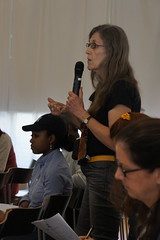 Stephanie Butnick Longtime East Village resident and community gardener Carolyn Ratcliffe speaking during the meeting.
Stephanie Butnick Longtime East Village resident and community gardener Carolyn Ratcliffe speaking during the meeting.East Village community gardeners attended a town hall meeting Saturday to express their concern that that recently revised rules governing community gardens don’t do enough to protect the green spaces from the threat of developers.
“This puts gardens in jeopardy,” Charles Krezell, a gardener who attended the meeting, said of the new rules. “We want all gardens protected for as long as they’re standing.”
In an interview before the meeting, Mr. Krezell, of the De Colores Community Yard on East Eighth Street, between Avenues B and C, said that many gardeners are worried that the new regulations don’t grant sufficient legislative protection to community gardens.
Indeed, some worry that East Village gardens may especially be at risk as area real estate continues to lure developers. Community gardeners fear that the wording of the new rules may leave gardens vulnerable.
Read more…











